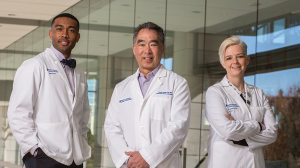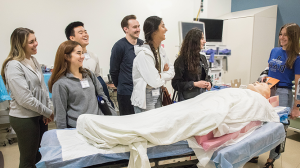The Changing Landscape of Medical School Admissions
If you want typical medical students, a typical admissions process might do.
But Duke University School of Medicine is not looking for typical medical students. That’s why the admissions process is tailor-made to go beyond transcripts and test scores to identify students who will not only thrive at Duke but will also have a significant impact throughout their careers.
“There is no typical Duke medical student,” said Joseph Jackson, MD, HS’04-’07, associate dean and director of the Office of Student Affairs. “That’s the beauty of it. They don’t all look a certain way, act a certain way, or have a certain background. But they all have a real sense of purpose and real drive to be leaders and change agents in the health professions field.”
More Essays + MMI = Holistic View
To help identify these change agents, the admissions committee has crafted an application and interview process designed to enable a holistic view of the applicants.
“Duke’s process is a lot more thorough than other schools,” said Braylee Grisel, a third-year medical student from Utah who serves on the admissions committee. “We have a lot more essays. You get more diversity when you get a better idea of the experiences the applicants have had.”
In place of a traditional interview, Duke uses multiple mini-interviews (MMI). Interviewees spend ten minutes at each of ten different stations, where they face challenging scenarios with no right or wrong answer, designed to elicit aptitudes related to ethics, critical thinking, cultural competency, emotional intelligence, and teamwork. Duke began using the MMI about a decade ago in the medical school, and now uses it in all its health professions programs, including Physician Assistant, Physical Therapy, and Occupational Therapy.
Linton Yee, MD, associate dean for admissions, said using the MMI allows the admissions committee to evaluate characteristics necessary for succeeding at Duke and beyond, such as communicating well with others. It also removes the potential for bias, because the “raters” who evaluate MMI performance don’t know anything about the interviewee except their name. Even at the one station that resembles a short traditional interview, the interviewer is not familiar with the interviewee’s application.
Grisel said the MMI gave her a chance to demonstrate strengths not measured by grades or standardized test scores. “I went to a state school not really known for being a pre-med factory, and I came from a low-income background and struggled a lot in taking the pre-med path,” she said. “[With the MMI], I felt like I could really demonstrate how well I understand patients from different backgrounds and my ability to think on my feet.”
Making it Better
Five or more students serve on the admissions committee each year. They evaluate applications, make presentations to the committee about applicants, and participate in the admission decisions.
“What surprised me was just how holistic the whole process was,” said committee member Edwin Owolo, a third-year student from Norwalk, Connecticut. “We weren’t super bogged down on any one detail, but we looked at them as a whole and what they could bring to the community at Duke.”
Grisel appreciated being able to provide context when the committee considered applicants from limited-resource circumstances. “I know Duke provides support to people coming from a place of not having had as many academic privileges,” she said, “so it makes me more comfortable to admit students from underprivileged backgrounds.”
The students also help improve the process for the future. “Every year we do a debrief with the students: what worked and what didn’t work,” Yee said. The admissions committee usually changes at least one of the eight required essays each year, and often tweaks the MMI stations as well.
One change that’s been spurred by students is to include a health-and-wellness lens when evaluating applications, not only in thinking about what applicants might need at Duke for their physical, emotional, and spiritual health, but also considering how applicants have navigated difficult situations in the past. “I’ve been in this arena for a while, and the dynamic of the students has changed,” Liu said. “Health and wellness is a priority for them.”
Students and applicants are also demonstrating a growing interest in advocacy and health disparities.
Going — and Staying — Virtual
In 2020, the COVID-19 pandemic forced a sudden switch to virtual interviews. It wasn’t easy. For example, the teamwork station previously had included a task involving Legos, which couldn’t be replicated over Zoom. “We had to come up with other ways for people to work together in a virtual setting so we could understand how they interact, how they listen, how they share information,” Liu said.
Virtual interviews turned out to have some distinct advantages, though. They ease the financial burden for students of traveling to multiple schools, for example. Grisel, who applied pre-pandemic, used funds provided by the Association of American Medical Colleges (AAMC) to help cover application fees, but there were no resources for travel. So she worked extra shifts at Starbucks, and her family started a GoFundMe site.
Even after most pandemic-related restrictions have eased, Duke and most other medical schools are still doing virtual interviews.
“It opened up our applicant pool and made it more diverse,” said Edward Buckley, BSE’72, MD’77, HS’77-’81, vice dean for education. “Our experience is positive enough that I don’t see us going back to face-to-face interviews.”
Why Students Choose Duke
Applicants are drawn to Duke not only for its excellence but also its renowned curriculum — which is now even more innovative with the ongoing rollout of the new “Patient First” curriculum. Applicants like the team-based learning that replaced the traditional lectures-and-exams curriculum a little more than a decade ago. And Duke is one of the only four-year medical schools that includes a full year for research. “When we ask [matriculants] why they chose Duke and not somewhere else,” Buckley said, “that is the number one reason.”
Owolo is spending his research year on three projects: investigating how breast cancer metastasizes to the spine, studying methods of decreasing health disparities among spine surgery patients, and improving diversity in the field of neurosurgery through outreach to undergraduate and high school students. “It’s an exercise in self-management, too,” he said, “trying to figure out how to balance a lot of different duties in the clinical and research space. It’s a big year for career development.”
Both Grisel and Owolo mentioned that Duke’s generous financial aid package made a difference.
And, for many students, intangibles factor into the decision.
“A lot of it was seeing the culture here and how supported everyone felt,” Grisel said. “Students seemed genuinely happy, and they made me feel welcome.”
Growing Diversity
As a group, Duke medical school students are becoming more diverse by almost any measure. Underrepresented minorities make up 29% of the current first-year class, and students whose parents didn’t complete a four-year degree constitute almost 7%.
At Duke, as at most other medical schools, a majority of applicants, accepted students, and matriculants are female — a dramatic shift from earlier eras. In 1980, only 25% of medical school graduates nationally were women. The current first-year class at Duke is more than 70% female. Buckley said that a large majority of students in the Physician Assistant, Physical Therapy, and Occupational Therapy Doctorate programs are female as well.
Yee speculates the shift could be due to the proliferation of Science, Technology, Engineering, and Math (STEM) programs for girls and young women that began a couple of decades ago. He also said there are many more role models for women in medicine now. “Now you can find women in ortho or surgery where in the past there were very few,” he said. “It’s not a roadblock anymore.”
Geographic diversity is increasing, with the largest group of first-year students coming from California, followed by North Carolina, Florida, Georgia, and New Jersey.
Applicants also have a greater diversity of experience, partly due to the increased popularity of gap years. About three-quarters of the current first-year students took one to three gap years. Sometimes the break is for travel; other times it’s to gain research or clinical experience.
“The real value with the gap years is to do something to help you understand why you want to undertake this [demanding profession] for the rest of your life,” Yee said.
Within all the diversity, one commonality unites Duke medical students, current and past: the desire to care for patients.
“[Students] have to really desire to care for patients and improve health care,” Yee said. “You cannot teach that.”




